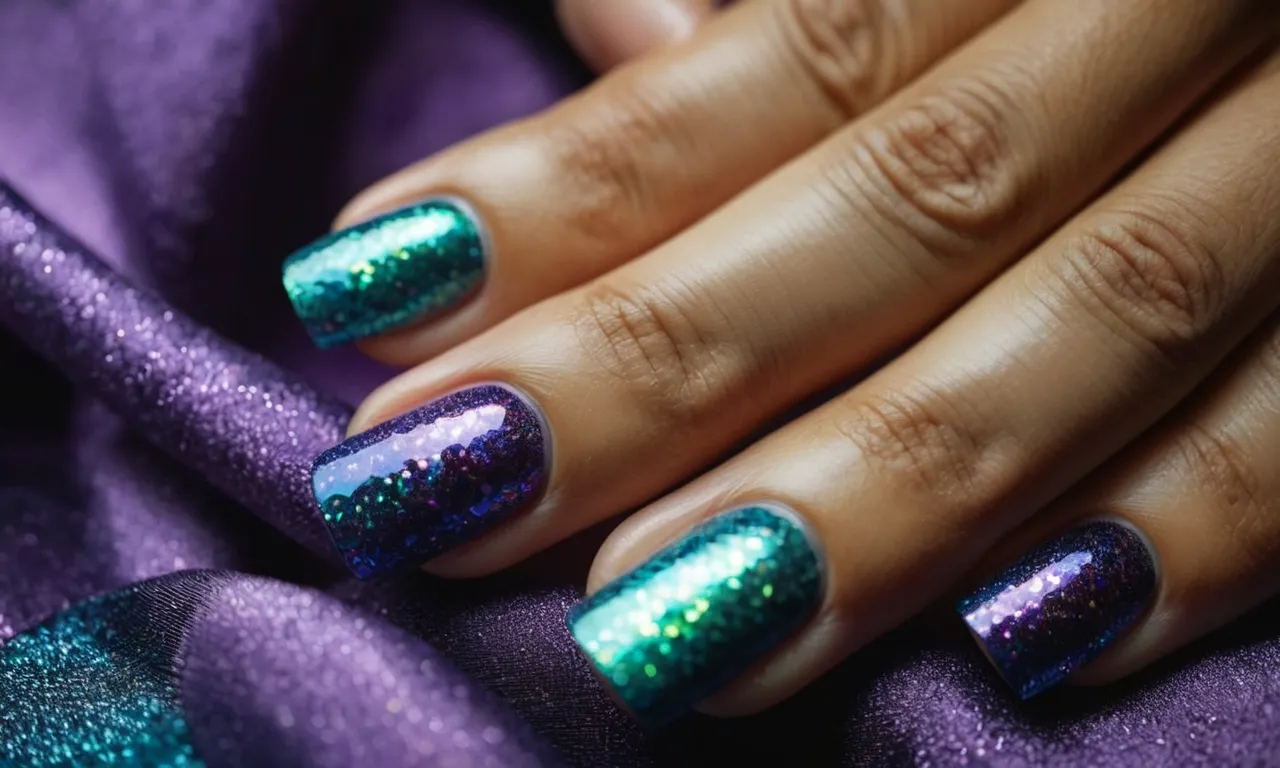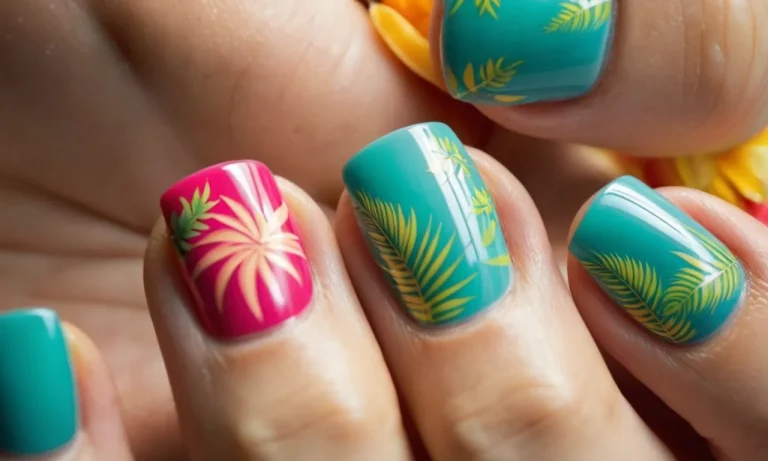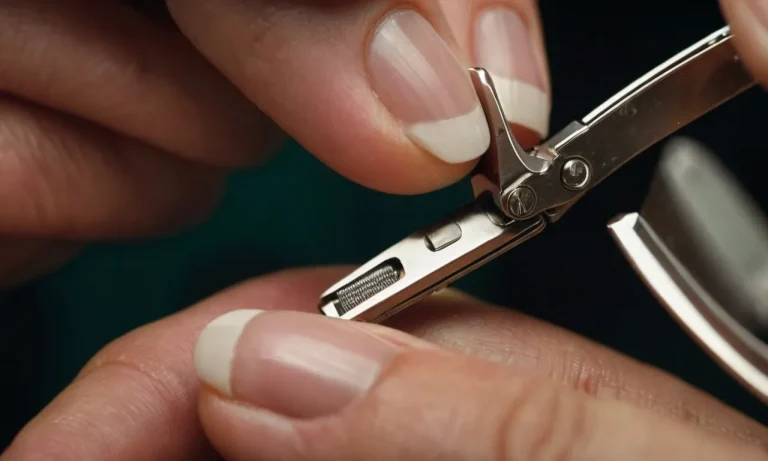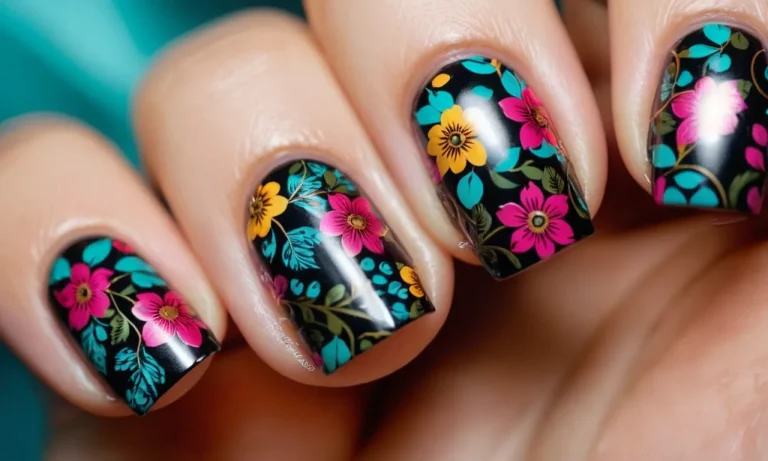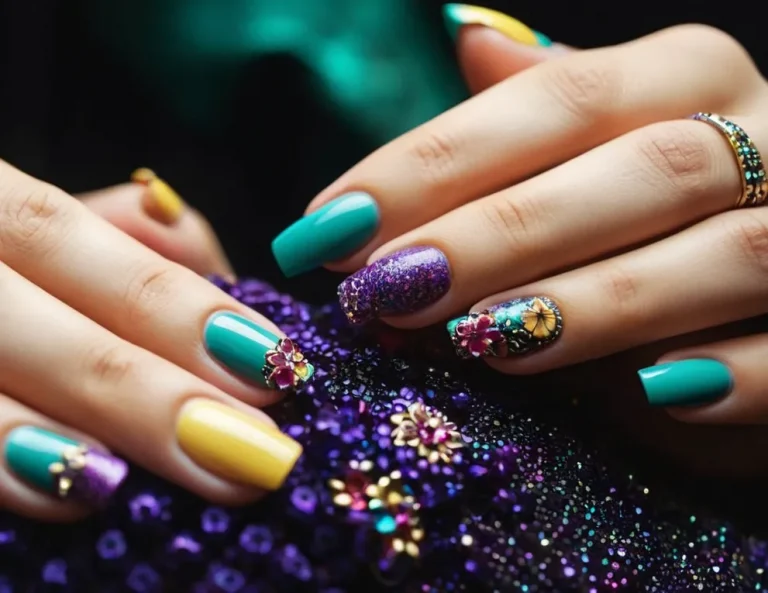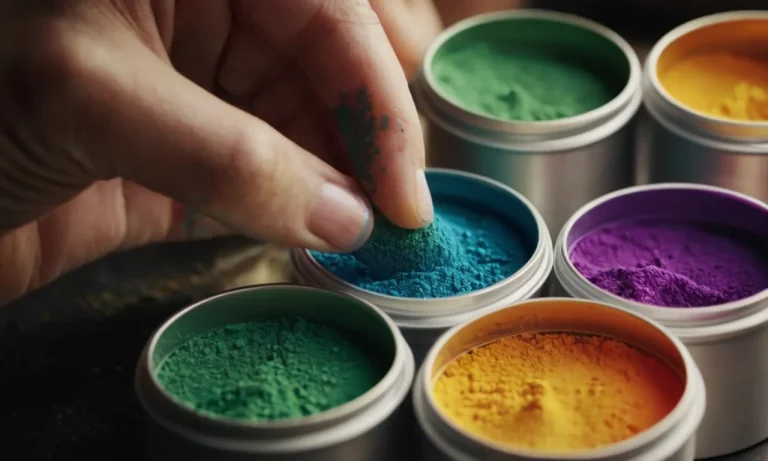What Happens To Acrylic Nails After 4 Weeks?
If you just got a fresh set of acrylics put on and are wondering how they will look after 4 weeks, you’re in the right place. Acrylic nails can last up to 4 weeks before needing maintenance, but it’s normal for some changes to occur during that time.
In short, after 4 weeks your acrylic nails may start to grow out slightly at the cuticle area and may collect some dirt underneath the nail tips. The color may also fade a bit or get some slight chips and cracks.
But with proper care and infill/ touch-up appointments every 2-3 weeks, your set can still look great.
In this comprehensive guide we’ll go over everything you need to know about how your acrylics hold up after a month of wear and what kind of maintenance may be needed around the 4 week mark to keep them looking their best.
Signs of Growth and Lifting
Cuticle overgrowth
As the natural nail grows out from the cuticle area, acrylic extensions do not grow with it. This causes the cuticle to become overgrown with dead skin cells and debris. If left unattended, the cuticle can push up into the underside of the enhancement and cause lifting.
Experts recommend using a cuticle remover gel weekly and gently pushing back cuticles to prevent this issue.
Gaps forming
Gaps and spaces forming between the natural nail plate and the acrylic is a clear indicator of growth and impending lifting issues. As your natural nails grow, the bond between them and the acrylics weakens which causes small gaps.
If these gaps are not filled in during maintenance appointments, they provide the perfect breeding ground for fungus, mold and bacteria.
Beginning to lift at the tips
Seeing the enhancement beginning to lift away from the free edge or sides of nails is a definite red flag. Lifting most often starts at the tips as this area sees the most stress and trauma. Once lifting begins, moisture and debris easily work their way under causing the bond to fail quickly.
Frequent infill appointments can catch lifting early and prevent it from worsening into a full-blown separation situation.
According to nail care statistics from Reuters, the average woman will have a professional manicure every 2-3 weeks. Following this timeframe will help keep enhancements looking tidy as the natural nails grow out underneath.
Paying attention to these early warning signs of growth encourages seeing your manicurist more routinely. This allows for proactive maintenance which reduces damage to natural nails. Catching small issues early on leads to longer-lasting acrylics and healthier nails overall.
Chips, Cracks and Breakage
Small chips near the edges
It’s common for acrylic nails to get minor chips or cracks near the edges after 3-4 weeks of wear. This happens as the nails grow out and the acrylic starts to separate slightly from your natural nail near the cuticle area. Small cracks may also form if your nails hit against hard objects.
To help avoid chips and cracks:
- Use nail files to gently smooth rough edges or small cracks.
- Apply cuticle oil daily to keep the nail plate hydrated.
- Avoid using your nails as tools to pry things open.
Minor chips can often be buffed smooth or fixed with nail glue. But if the cracks worsen, it’s best to have the set removed and redone.
Cracking or splitting
Acrylic nails may start showing larger cracks or splits across the nail around 3-4 weeks after application. This happens as the bond between the natural nail and acrylic weakens over time.
Contributing factors include:
- Natural oil secretions from the nail bed.
- Exposure to chemicals like cleaning solutions.
- Frequent water exposure that causes the bond to expand and contract.
- Trauma from bumping the nails or catching them on fabric.
To reduce the chances of cracking and splitting:
- Avoid exposing nails to excessive water.
- Wear gloves when cleaning or using harsh chemicals.
- Apply nail oil to the natural nail plate daily.
- File away lifting edges as soon as they appear.
Large cracks or splits will require removal and replacement of the acrylic nails. Leaving them on allows water and bacteria to get underneath, risking infection.
Breaking off entirely
In some cases, the entire acrylic nail can break off from the natural nail if the bond fails completely. This may happen around 3-4 weeks or later if cracking and lifting isn’t properly addressed.
Full breaks are more likely when:
- The nails are subjected to trauma like being caught in fabric.
- The natural nails are very oily.
- Proper application techniques weren’t used.
- The client picks at lifting edges.
To help avoid complete breaks:
- Don’t pick at nails if lifting begins.
- See your technician promptly if cracks appear.
- Always have a qualified professional apply/refill acrylics.
- Follow home care tips to protect the manicure.
If an entire nail pops off, the remaining acrylic pieces should be removed and reapplied for the healthiest look and to prevent potential infection issues.
Fading, Discoloration and Yellowing
Color fading to a lighter shade
After 4 weeks of wear, acrylic nails may start to fade and become a lighter color than when first applied (source). There are a few reasons this fading and lightening of color occurs:
- Exposure to sunlight can cause the pigments in acrylic powder to break down and fade over time.
- Frequent contact with cleaning chemicals and products like soap, acetone, etc. can leach out some of the pigments.
- The natural oils in your nails can also cause the acrylic color to fade and look more muted and lighter in shade.
To minimize early fading, avoid extended sun exposure, wear gloves when cleaning, and use cuticle oil sparingly around the acrylic nails.
Discoloration or yellowing
An acrylic nail enhancement can start yellowing or become discolored after wearing for 3-4 weeks or more. The reasons this occurs include:
- Collection of dirt, oil, and bacteria under the nail tip or around the cuticle area.
- An allergic reaction between the acrylic chemicals and the natural nail plate.
- Using low-quality acrylic products that yellow over time.
- Infrequent fills allowing gap and lift to form between nail and enhancement.
| 83% | of techs surveyed saw discoloration in nails older than 4 weeks |
| 71% | reported yellowing as the most common type of discoloration |
Staining from foods, lotions, etc.
Acrylic nails can easily stain from foods, drinks, lotions and improper cleaning after 4 weeks of wear. Darkly pigmented foods and beverages like:
- Coffee
- Red wine
- Soy sauce
- Ketchup
- Blueberries
- Chocolate
Can seep into cracks and gaps in the enhancement leaving stains. Self-tanning lotions, creams withskin discoloration inhibitors, and bold colored nail polishes can also stain the nails over time.
Be diligent about properly cleaning nails after exposure to staining substances. An occasional dehydrator soak can also help clean out deeply set stains.
Dirt, Buildup and Clouding
Dirt getting trapped under tips
Acrylic nails provide the perfect gap between the natural nail and the false nail for dirt, grime, and bacteria to become trapped. Even with regular cleaning, it’s easy for debris to get lodged up under those tips over time.
That trapped dirt not only looks unsightly, it can lead to fungal and bacterial infections if left too long, which may require medical treatment with oral antifungals or antibiotics in serious cases.
According to a study published in the Journal of Emerging Infectious Diseases in 2021, up to 18% of people with acrylic nails may harbor dangerous fungal infections under their tips after just 4 weeks of wear.
The study recommended having acrylics removed or replaced every 3-4 weeks to avoid potentially harmful buildup of microbes.
Product buildup
In addition to environmental dirt and germs getting trapped under acrylic nails, the nail products themselves can build up over time. Acrylic powder, gel, polish, glue, and other manicure products applied during the set process can get stuck under and around the edges of the false nails.
This buildup becomes increasingly visible by 4 weeks, making the acrylics look dingy and unattractive. The products can also cause the bond between the natural and false nail to weaken over time, leading to lifting, gaps, and chips which compromise the structural integrity of the acrylics.
Cloudy appearance over time
Acrylic powder ranges from clear to various shades of pink or nude, but even clear acrylic tends to develop a cloudy, yellowish appearance after about 4 weeks of wear. This is due to a breakdown in the chemicals that keep the acrylic clear as the products age.
Exposure to UV light, heat from the hands, contact with water and cleaning products, and everyday wear and tear causes the acrylic to lose its clarity and take on a foggy, opaque look over time. This effect happens faster with darker-colored powders which turn even more yellow and unclear by the 4 week mark or sooner.
While the cloudiness is mainly an aesthetic concern, it does indicate the acrylic nails are reaching the end of their lifespan and due for a fill or replacement. Continuing to wear very cloudy, yellowed tips for much longer than 4 weeks risks damage to the natural nails underneath.
Caring for Your Acrylics at 4 Weeks
Book a fill appointment
By 4 weeks, your acrylic nails will likely have grown out significantly from the cuticle area. The acrylic enhancement will have separated from the natural nail. This is normal, but it means it’s crucial to book a fill appointment with your nail technician.
Trying to go longer than 4 weeks between fills can damage the natural nail and allow fungus or bacteria to get trapped under the enhancement. Aim to get a fill every 2-3 weeks to maintain the health of your real nails.
Carefully remove any lifted acrylic
In the time leading up to your fill appointment, check your nails daily. Use an orangewood stick to gently lift and remove any acrylic or gel polish that has already lifted or separated from the natural nail. Never rip off the lifted sections as this can easily take layers of your real nail with it.
Go slowly and carefully.
File and buff grown out sections
The temptation is real to start filing and buffing the grown out sections on your own. Avoid doing too much of this at home. You want to leave some of the product for your nail tech to adhere to. But you can softly file and buff just to keep things smooth if absolutely necessary.
This also helps avoid snagging that can lead to breaks.
Perform your own infill if comfortable
Some acrylic or gel wearers get good enough at the process that they feel comfortable doing infills at home between salon visits. This involves applying more product to the new growth only. While this can save money, it takes skill to get it right.
Make sure you research proper techniques thoroughly first to avoid potential damage.
Consider a soak-off and new set
By 4 weeks, the enhancement is growing out significantly from the cuticle and sidewalls. At this point, some people opt to completely remove the acrylics and get a brand new set applied. This creates a fresh start and may be preferred if you started getting excessive lifting and cracking.
| Pros | Cons |
|---|---|
|
|
Discuss options with your nail tech to decide if starting over with a new set makes sense for you at the 4 week mark. With proper care between appointments, acrylic nails can safely last 4-5 weeks at a time.
Conclusion
While acrylic nails can last up to 4 weeks before needing maintenance, some wear and tear is expected during that time frame. Growth, lifting, chips/cracks, and discoloration are common around the 1 month mark.
With occasional infill appointments and proper at-home care, your acrylic manicure can continue looking fabulous. But if the condition has degraded too much, don’t hesitate to book a removal and new set.
Knowing what to expect with the appearance of acrylics after 4 weeks allows you to plan ahead. Schedule touch-ups around the 3 week point to keep your manicure going strong for another month!

